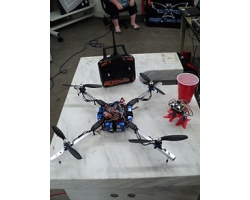- Home
- Others
- Others News
- A flying robot to help in search and rescue operations
A flying robot to help in search-and-rescue operations

Designed by Saxena, assistant professor at Cornell, the flying robot, the size of a card table is able to guide itself through forests, tunnels or damaged buildings.
The toughest part is keeping the object from slamming into walls and tree branches.
Human controllers can't always react swiftly enough and the radio signals may not reach everywhere the robot goes, according to a Cornell statement.
So, Saxena, who did his B.Tech. in 2004 from the Indian Institute of Technology (IIT) Kanpur, in a bid to overcome these limitations is building on methods he previously had developed to turn a flat video camera image into a 3-D model.
He used such cues as converging straight lines, the apparent size of familiar objects and what objects are in front of or behind each other the same cues humans unconsciously use to supplement their stereoscopic vision.
The flying robot was tested in 53 autonomous flights in obstacle-rich environments including Cornell's Arts Quad succeeding in 51 cases, failing twice because of winds.
The test vehicle is a quadrotor, a commercially available flying machine about the size of a card table with four helicopter rotors.
Graduate students Ian Lenz and Mevlana Gemici trained the robot with 3-D pictures of such obstacles as tree branches, poles, fences and buildings. The robot's computer learns the characteristics all the images have in common, such as colour, shape and texture.
The resulting set of rules for deciding what is an obstacle is burned into a chip before the robot flies.
In flight, the robot breaks the current 3-D image of its environment into small chunks based on obvious boundaries, decides which ones are obstacles and computes a path through them as close as possible to the route it has been told to follow.
Saxena plans to improve the robot's ability to respond to environment variations such as winds and enable it to detect and avoid moving objects, like real birds.
The results were presented at the International Conference on Intelligent Robots and Systems in Portugal during early October.
Get your daily dose of tech news, reviews, and insights, in under 80 characters on Gadgets 360 Turbo. Connect with fellow tech lovers on our Forum. Follow us on X, Facebook, WhatsApp, Threads and Google News for instant updates. Catch all the action on our YouTube channel.
- Samsung Galaxy Unpacked 2025
- ChatGPT
- Redmi Note 14 Pro+
- iPhone 16
- Apple Vision Pro
- Oneplus 12
- OnePlus Nord CE 3 Lite 5G
- iPhone 13
- Xiaomi 14 Pro
- Oppo Find N3
- Tecno Spark Go (2023)
- Realme V30
- Best Phones Under 25000
- Samsung Galaxy S24 Series
- Cryptocurrency
- iQoo 12
- Samsung Galaxy S24 Ultra
- Giottus
- Samsung Galaxy Z Flip 5
- Apple 'Scary Fast'
- Housefull 5
- GoPro Hero 12 Black Review
- Invincible Season 2
- JioGlass
- HD Ready TV
- Laptop Under 50000
- Smartwatch Under 10000
- Latest Mobile Phones
- Compare Phones
- OnePlus 15R
- Realme Narzo 90x 5G
- Realme Narzo 90 5G
- Vivo S50 Pro Mini
- Vivo S50
- OPPO Reno 15c
- Redmi Note 15 5G
- Redmi Note 15 Pro 5G
- Asus ProArt P16
- MacBook Pro 14-inch (M5, 2025)
- Infinix Xpad Edge
- OnePlus Pad Go 2
- OnePlus Watch Lite
- Just Corseca Skywatch Pro
- Acerpure Nitro Z Series 100-inch QLED TV
- Samsung 43 Inch LED Ultra HD (4K) Smart TV (UA43UE81AFULXL)
- Asus ROG Ally
- Nintendo Switch Lite
- Haier 1.6 Ton 5 Star Inverter Split AC (HSU19G-MZAID5BN-INV)
- Haier 1.6 Ton 5 Star Inverter Split AC (HSU19G-MZAIM5BN-INV)












